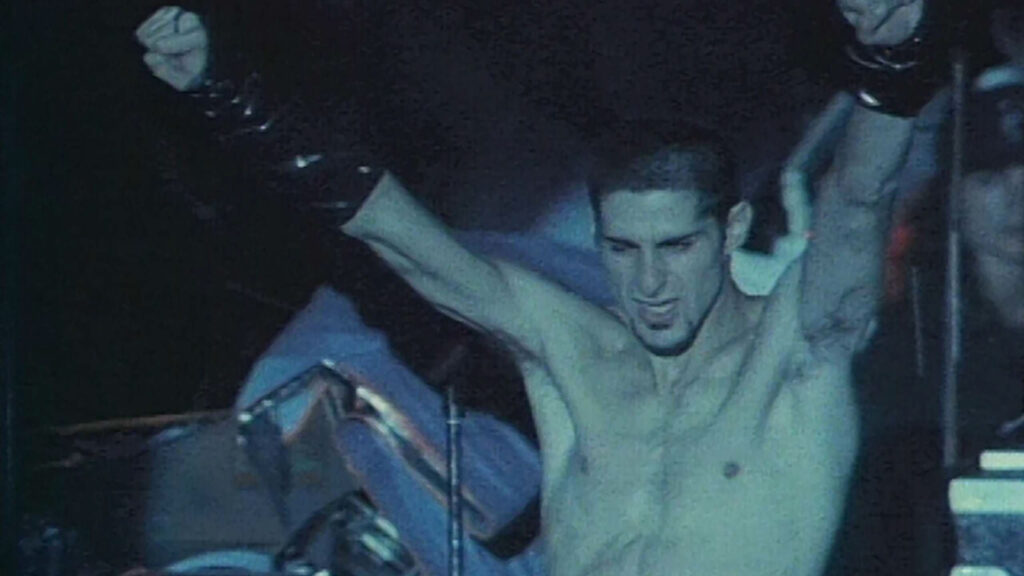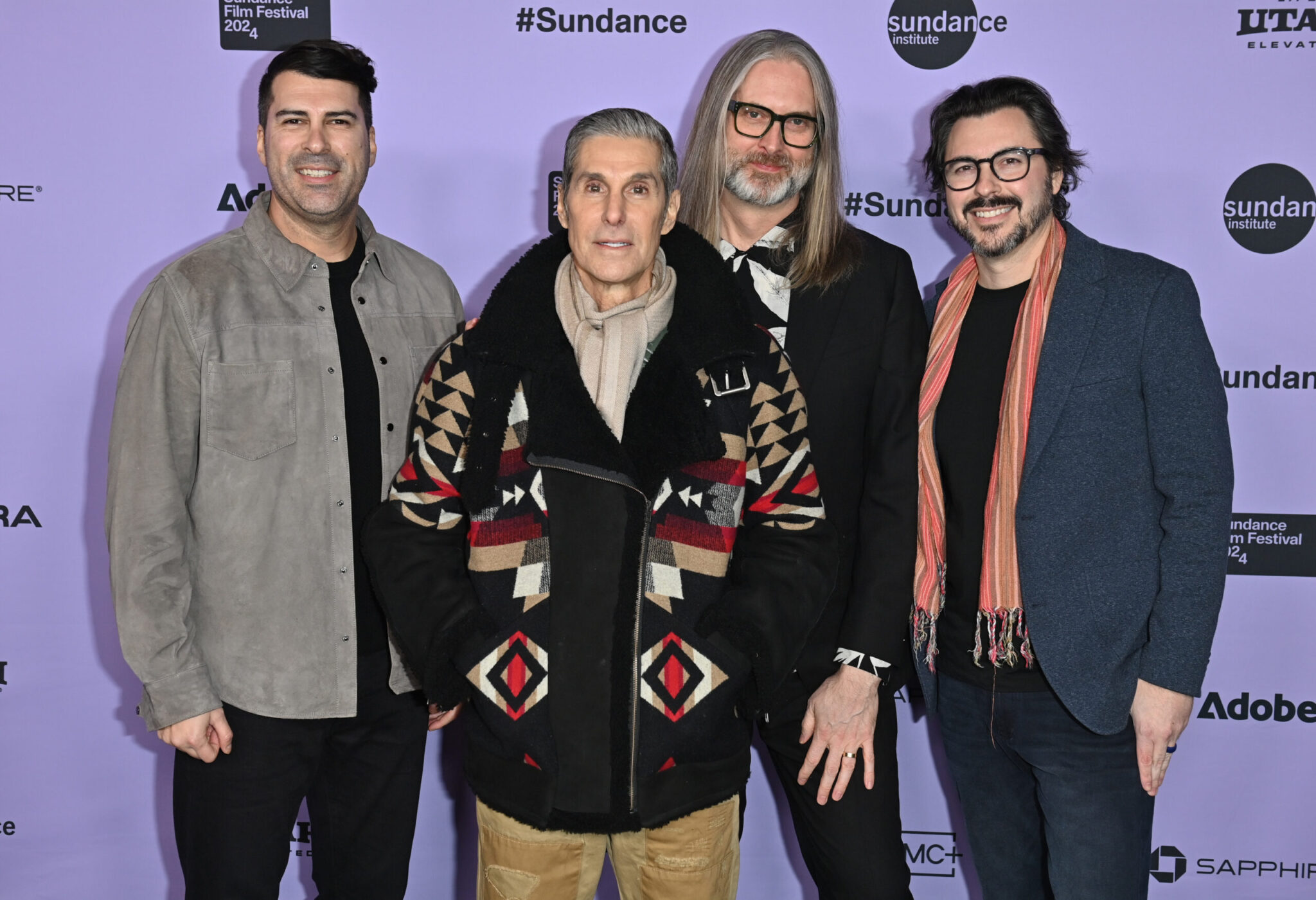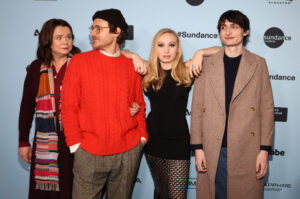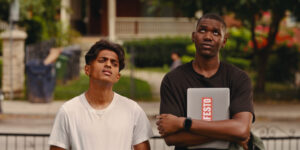James Lee Hernandez, Perry Farrell, Michael John Warren and Brian Lazarte. (Photo by George Pimentel/Shutterstock for Sundance Film Festival)
by Veronika Lee Claghorn
At 10:30 p.m. on a Thursday night in January 2024, hundreds of people dress in flannels, ripped jeans, beanies, and boots as they lollygag into a high school auditorium. It’s not a scene from 1997 but the present, marking the world premiere of LOLLA: THE STORY OF LOLLAPALOOZA at Eccles Theatre in Park City, Utah, for the 40th edition of the Sundance Film Festival.
Charles Dickens’ famous words, “It was the best of times, it was the worst of times…” could easily describe the early 1990s. The Persian Gulf War and Pedro Zamora revealing a terrifying “new” illness called AIDS on MTV’s The Real World were part of that era. People embraced piercings and tattoos, held jobs allowing them to sleep until 11 a.m., and, as Portlandia suggested, were kind of okay with being unambitious.
So leave it to Perry Farrell, the writhing surfer-y neon-haired leader of Jane’s Addiction, to found the world’s most uncommercial corporate rock fests of all modern history: Lollapalooza. LOLLA: The Story of Lollapalooza, directed by Michael John Warren (HBO’s Spring Awakening, Amazon’s Free Meek, Fade To Black), interviews and extrapolates from the most important players in the ‘90s scene. From Ice-T to Tom Morello to riot grrrls from Babes in Toyland, this episodic series based on the quintessential alternative music era narrates the tale of sound and fury of a generation that rose out of the political and personal places where screams were born.
Warren, once an angsty teen in the ‘90s, shares his experiences, followed by Sundance Film Festival Programmer Adam Montgomery, who reminisces about attending the festival in 1997. Warren proudly declares himself a member of Generation X, or as he puts it, “Generation F**k You!” The audience cheers. Warren advises against meeting your heroes but praises Perry Farrell, the focal point of the documentary series.
Banging their heads to the bassline from “Mountain Song” by Jane’s Addiction, viewers seem familiar with the story. Before Coachella and influencers, there was Lollapalooza. Born of Farrell’s artistic genius, Lollapalooza helped catapult bands like Tool, Nine Inch Nails, and Rage Against the Machine. DIY but viable bands out of the late ‘70s and ‘80s such as Siouxie and the Banshees, Sinéad O’Connor, and the Ramones rocked out with fearless acts including Farrell’s own bands (Jane’s Addiction and Porno for Pyros), the twisted Jim Rose Circus sideshow act, Ice-T’s Body Count, and more.
Lollapalooza was never for posers, and this series maps the trajectory of the summer jubilee from its wildly successful early days to low moments, like when Kurt Cobain refused $6 million to tour with the festival because he claimed, “The people in the audience are the same kind of people who used to beat me up in school.”
Lollapalooza was where Trent Reznor screamed “Head Like a Hole,” long before Netflix invited Miley Cyrus to cover it for Black Mirror. Ice-T belted out “F*ck the Police” nightly, with Chris Cornell of Soundgarden doing his own rendition before Black Lives Matter existed or Rodney King fell to the hands of police brutality. Tom Morello of Rage Against the Machine fame said backstage in 1993, “I don’t think we should be fooled just because Clinton is in office that he’s not serving the same interests as the ones Reagan and Bush served.”
Morello’s words ring just as true now 30 years later, as young people are questioning the lines that really seem to connect, not divide, political factions. In a modern world where musicians have to fear speaking out against the political powers that be, Lollapalooza dared to book artists unafraid to stand up against any and every authority. To be a poser in Perry Farrell’s lollipop universe; to be inauthentic, was the biggest crime of all and audiences today, satiated on the social media status quo drip, may be shocked at the lengths bands like Hole, Sonic Youth, the Beastie Boys, DEVO, Radish, Cypress, Babes in Toyland, Smashing Pumpkins, and many more took to assume their credit in the straight world.

At the screening’s conclusion, Farrell, dressed in seemingly unconventional attire (khakis and a buttoned-up shirt), joins Warren, producers James Lee Hernandez and Brian Lazarte of FunMeter Production Company onstage, met with concert-like fanfare. He praises the series, celebrating the “passion” behind it. “Back then there were no cell phones, man… what you are seeing here [in that 20,000 hours of footage] is raw passion. There were clubs that you didn’t know about. They weren’t easy to find. You had to learn by word of mouth and you had to trust in the person who was telling you about it, and you would just go and you’d hang out.”
An audience member asks about Lollapalooza selling out, and Farrell says money is never a part of his master plan since he started out as an underground artist. He explains that he never envisioned making a lot of money and that he came from hanging out with musicians, not people obsessed with finances. “You have to really love music and have a reason to make it. It can’t be money — you can hear that, and that’s a terrible sound to me.”
At one point, Farrell says his kids inspire him, especially with what music they listen to. He asks his son, Izzadore, in the audience who he was playing that morning. “Izzy” responds with “Karen Dalton,” and his father jokes, “Oh cool. Well, I’ll book her next if she’s still alive.” Farrell then joins Montgomery in shouting out MTV veteran Matt Pinfield who is in the audience. “Thanks for doing the work all these years, man!” shouts Farrell.
As the doors to Eccles close to theatergoers, many shuffle outside into the winter night, talking about “the good old days.” Before calling his Uber, one long-haired gentleman from the crowd tells his friend, “Hell yeah! That makes me want to get up and start a mosh pit!”
That would probably make Mr. Farrell pretty happy to hear.
LOLLA: THE STORY OF LOLLAPALOOZA is a part of the Episodic series.







